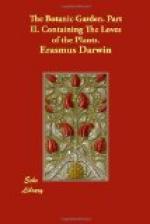245 Steep’d in fell poison, as his sharp teeth
part,
A
thousand tongues in quick vibration dart;
Snatch
the proud Eagle towering o’er the heath,
Or
pounce the Lion, as he stalks beneath;
Or
strew, as marshall’d hosts contend in vain,
250 With human skeletons the whiten’d plain.
—Chain’d
at his root two scion-demons dwell,
Breathe
the faint hiss, or try the shriller yell;
Rise,
fluttering in the air on callow wings,
And
aim at insect-prey their little stings.
255 So Time’s strong arms with sweeping scythe
erase
Art’s
cumberous works, and empires, from their base;
While
each young Hour its sickle fine employs,
And
crops the sweet buds of domestic joys!
With blushes bright as morn fair ORCHIS charms,
260 And lulls her infant in her fondling arms;
[Orchis. l. 259. The Orchis morio in the circumstance of the parent-root shrivelling up and dying, as the young one increases, is not only analogous to other tuberous or knobby roots, but also to some bulbous roots, as the tulip. The manner of the production of herbaceous plants from their various perennial roots, seems to want further investigation, as their analogy is not yet clearly established. The caudex, or true root, in the orchis lies above the knob; and from this part the fibrous roots and the new knob are produced. In the tulip the caudex lies below the bulb; from whence proceed the fibrous roots and the new bulbs; and I suspect the tulip-root, after it has flowered, dies like the orchis-root; for the stem of the last year’s tulip lies on the outside, and not in the center of the new bulb; which I am informed does not happen in the three or four first years when raised from seed, when it only produces a stem, and slender leaves without flowering. In the tulip-root, dissected in the early spring, just before it begins to shoot, a perfect flower is seen in its center; and between the first and second coat the large next year’s bulb is, I believe,




